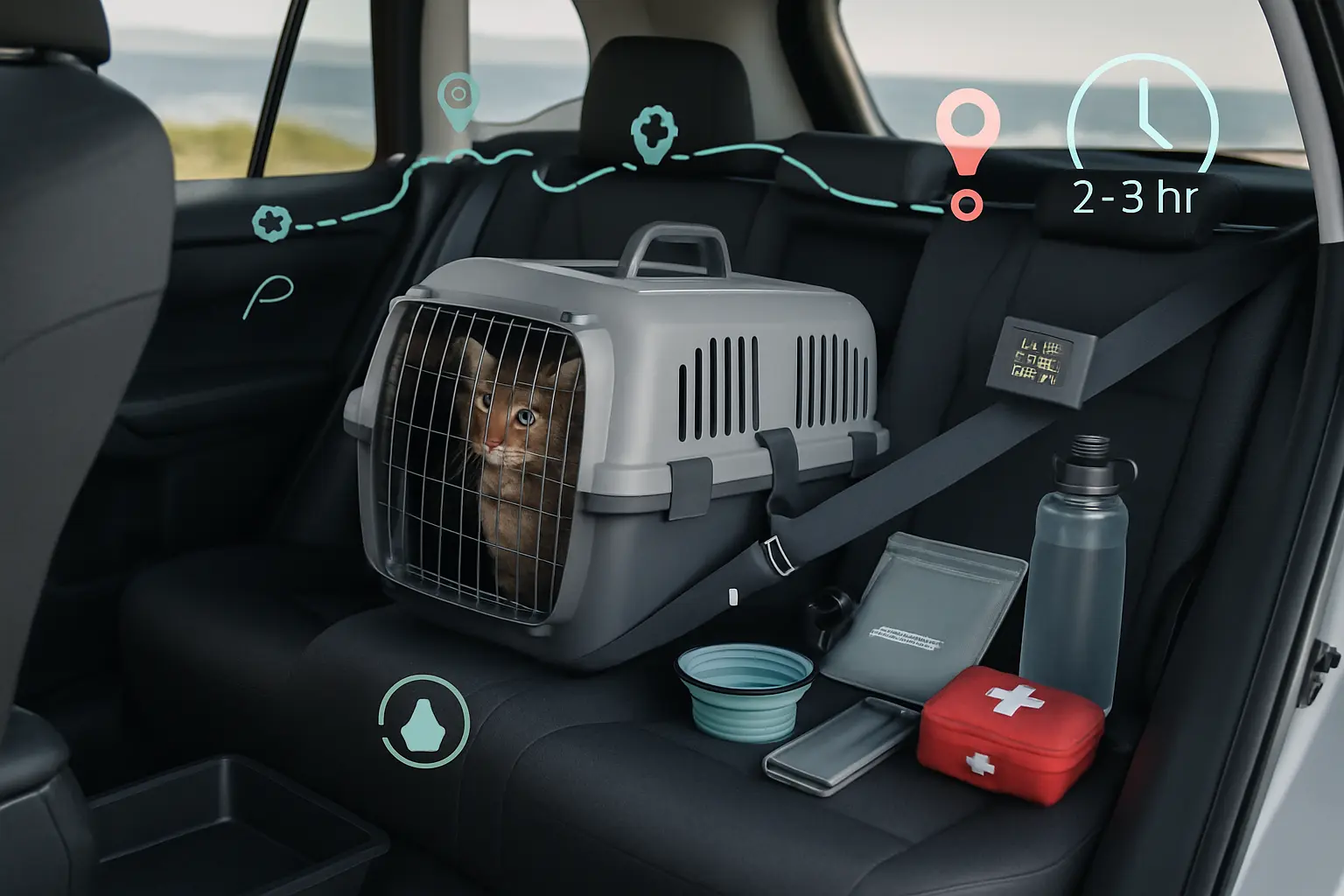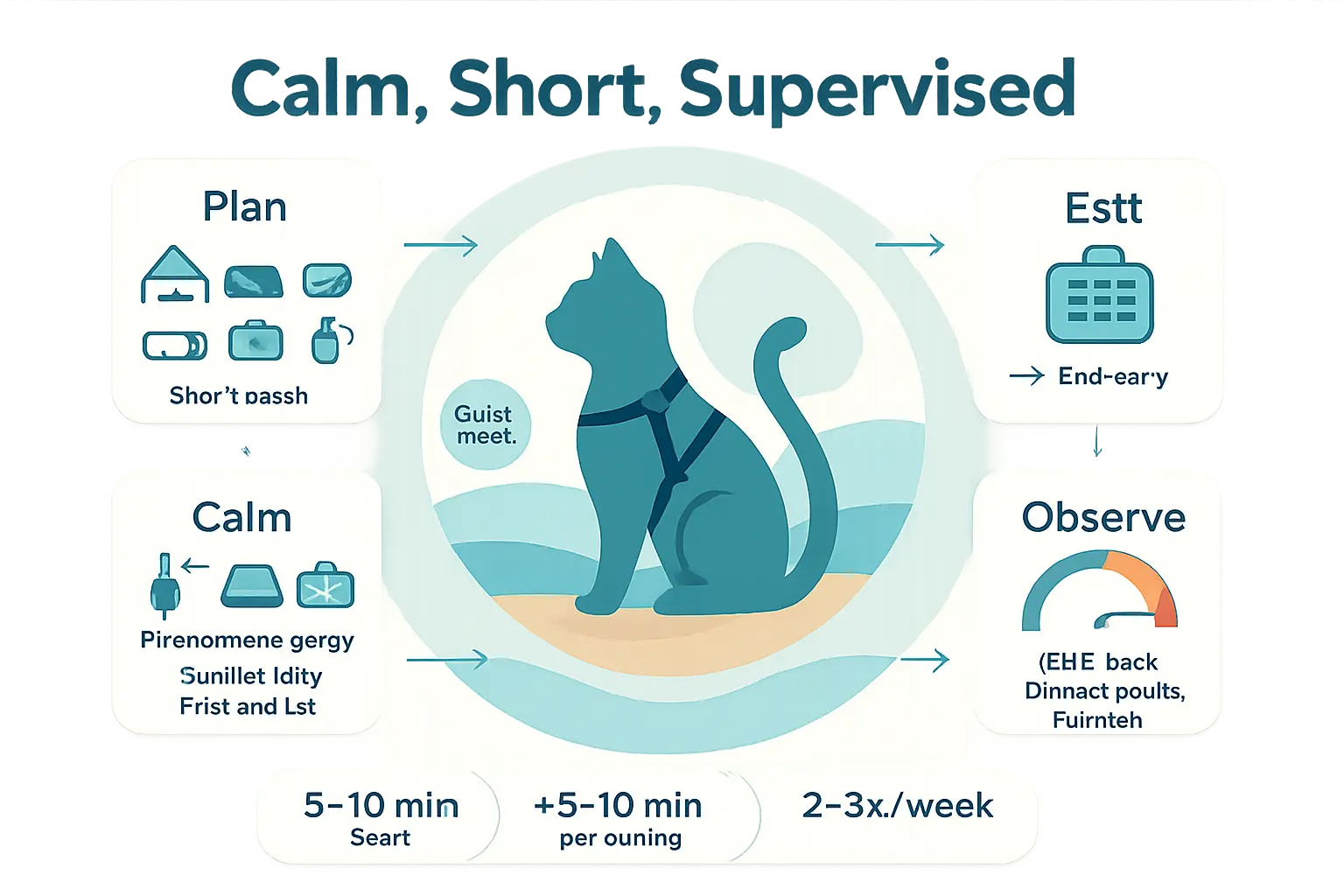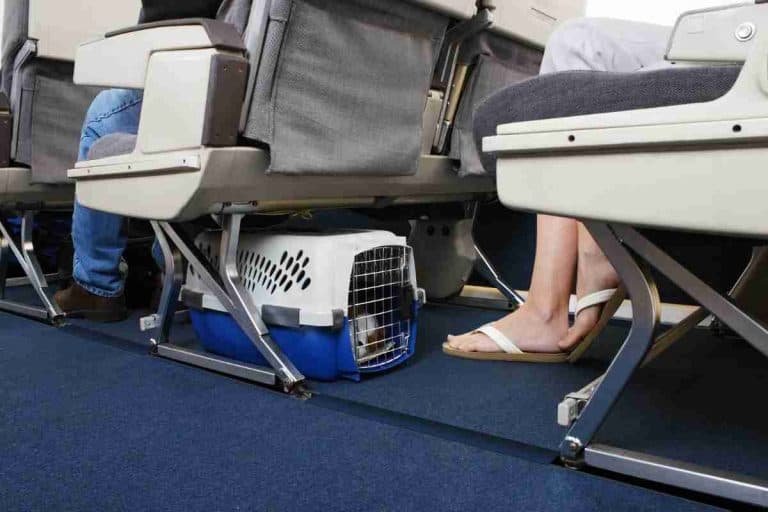24 Essential Tips for Taking Your Cat to the Beach
Last Updated on September 9, 2025
Taking your cat to the beach can be safe and enriching—when every detail is planned. Not every feline enjoys surf and sand, though. Owners should weigh temperament, health, and travel tolerance before committing. 24 Essential Tips for Taking Your Cat to the Beach shows how to decide, prepare, and protect. One missed step can mean escapes, heat stress, or fines—avoidable with smart planning.
Owners will learn to check pet-friendly beach rules, update vaccines and microchips, and plan flea and tick prevention. The packing checklist covers pop-up shade, a cooling mat, hydration, portable litter, pet-safe sunscreen, and a secure harness and leash. Road, ferry, and flight sections explain carrier requirements and temperature control. On‑shore strategies address leash etiquette, dog encounters, water hazards, sun protection, and paw care. Post‑beach routines—rinsing, injury checks, and logging—keep the next visit safer.
Should you take your cat to the beach?
Deciding whether to bring a cat to the beach starts with a clear risk-versus-reward check. Owners should weigh the cat’s likely stress level against the benefits of shared time outdoors. Key considerations include the cat’s health, mobility, and tolerance for noise and unfamiliar terrain. Avoid beaches when the cat has recent illness, is elderly, or is unvaccinated. Consider environmental risks like hot sand, saltwater ingestion, sunburn on pale ears, shorebirds, and busy crowds.
Logistics matter: can the cat ride safely in a carrier, and will the owner manage shade, fresh water, and secure containment? A short trial outing to a quiet shoreline-adjacent park reveals most behavior patterns faster than speculation. If planning longer travel, assess overnight options and transport stress. For owners who plan multi-site trips or use a vehicle outfitted for pets, resources on traveling with cats in an RV offer useful parallels about containment and creature comforts.
If doubts remain, postpone the trip. A single stressed escape can cause lasting issues. When ready, approach the beach as a controlled experiment: one calm visit, strict containment, and a clear exit plan.
Gauge your cat’s temperament, age, and previous travel experience
Assess temperament objectively. Bold, leash-trained cats sometimes adapt to new environments. Timid or escape-prone cats rarely do. Note reactions to car rides, carriers, and crowds during short practice trips. Look for motion-sickness signs such as drooling, heavy panting, or vomiting.
Age and medical status change the risk profile. Kittens under four months need vaccinations. Senior cats may tire quickly and handle heat poorly. Pregnant cats should not travel unless a vet clears them. Ask a veterinarian about sedatives only when necessary and safe.
Train gradually. Practice harness walks in quiet areas, then increase stimuli. Use short sessions, high-value treats, and praise. Monitor stress signals: flattened ears, wide pupils, hissing, or frantic attempts to flee. If these appear repeatedly, the beach is not the right environment for that cat. For owners who struggle with car anxiety, see tips on how to calm down a cat in the car before attempting longer travel.
Verify local beach rules, leash laws, and seasonal restrictions
Confirm rules before departure. Municipal and state beaches vary on pets, leash requirements, and seasonal bans. Consult official park websites, local ordinances, or park rangers. A quick call to the parks department prevents fines and stressful confrontations.
Check for wildlife protections and nesting seasons. Many beaches close sections during bird breeding months. Also verify time-of-day rules; some beaches allow pets only before dawn or after dusk. Tide schedules affect usable sand and safe shaded areas. Note that enforcement levels differ—some locations issue citations, others remove animals.
When in doubt, treat venue policies like any other retailer rule. Owners can learn from examples such as store and venue pet policies documented online; for a practical example about checking pet access rules, see are dogs allowed in Cabela’s. Pack documentation: proof of rabies vaccination, a photo ID microchip number, and local contact info. These items smooth interactions with officials and speed reunification if separation occurs.
Weigh alternatives (pet sitter, cat-friendly lodging, nearby parks)
Alternatives often reduce risk while keeping the cat safe and content. A professional pet sitter maintains routine and avoids travel stress. Boarding facilities provide supervision, but choose one with strong cleanliness and low-noise practices. Cat-friendly lodging can work if the cat tolerates transit and temporary spaces.
Nearby parks and quiet waterfronts replicate the beach’s sensory experience without the same hazards. Short, frequent outings to these locations offer enrichment with less escape risk and no saltwater exposure. For cats that truly dislike travel, consult resources on traveling with anxious felines to explore non-travel enrichment and low-stress options.
Prepare an alternatives checklist: a sitter with references, vaccination records, emergency vet details, and a list of the cat’s calming routines. Book sitters or lodging well in advance for peak seasons. If owners opt for a sitter, include a clear care plan and a CTA: schedule a meet-and-greet and a trial day before the beach trip to confirm compatibility.
Vet visit and identification checks before the trip
The owner should schedule a veterinary appointment at least two weeks before the beach day. The vet will confirm the cat is healthy enough for travel and note any restrictions. Bring recent medical records and a copy of vaccination history to the visit. Verify whether a health certificate or specific paperwork is required by local authorities or accommodations. Check the carrier and harness for secure fit and comfort, and confirm the cat tolerates short practice trips. Prepare printed and digital copies of ID, vaccination records, and the veterinarian’s contact information. Update emergency contact names and phone numbers before departure. Consider the local risks at the beach—saltwater, heat, and parasites—and ask the vet for region-specific advice. Owners who plan longer road or RV trips can consult resources on traveling with cats in an RV for carrier and confinement best practices. Schedule follow-up calls if the vet prescribes any pre-trip treatment. Finally, book the appointment now rather than later—last-minute exams reduce options for preventives and paperwork.
Pre-trip health check, vaccines, and flea/tick prevention
The pre-trip exam should confirm core vaccinations and parasite protection are up to date. Ask the veterinarian to review the cat’s vaccine schedule and recommend boosters based on age and local disease risk. Document rabies and FVRCP status, and request a vaccination certificate if needed for accommodations. Discuss flea, tick, and heartworm prevention appropriate for the destination. Apply topical or oral preventives within the vet-recommended window so products reach full efficacy before exposure. Inspect ears, eyes, teeth, and skin for signs of infection or parasites during the visit. Submit a fecal test if diarrhea or weight loss occurred recently; treating intestinal parasites before travel avoids complications. Record the timing and type of every preventive in a travel folder. If the cat has chronic conditions, obtain a clearance letter and dosage schedule for medications. For behavioral concerns or travel sensitivity, consult practical advice on how to travel with a fussy feline so health steps align with comfort strategies.
Medication plan: motion sickness, anxiety, and emergency meds
The owner must create a written medication plan with the veterinarian. Identify prescription options for motion sickness, such as antiemetics, and discuss safe sedatives for anxiety. Request specific dosing instructions, timing relative to travel, and possible side effects to monitor. Include non-prescription supports: pheromone sprays, familiar bedding, and short-acting calming formulas the vet approves. Pack all medications in labeled containers with original packaging and a photocopy of the prescription. Add a basic feline first-aid kit with gauze, antiseptic wipes, and the vet’s emergency phone number. For allergic reactions or sudden severe events, confirm whether the vet will provide an emergency injection or a plan to get to the nearest emergency clinic. Keep medications and the first-aid kit in an easily accessible cooler or bag. For behavioral mitigation and ride-prep techniques, see tips on how to calm down a cat in the car.
Update collar tags and confirm microchip registration
Update collar tags with the owner’s current phone number and a secondary contact. Use a durable, waterproof tag and print legibly. Add temporary travel details on a second tag, such as the destination city or lodging phone number. Verify the collar fits snugly but allows two fingers under the strap. Check the microchip number against registration records and update contact information in the chip database before leaving. Carry a recent, clear photo of the cat to aid identification if separation occurs. Consider adding a temporary GPS tracker or placing identification inside the carrier. If the cat will be secured in an RV or carrier, reinforce attachment points and test closures to prevent escapes—see guidance on how to keep cats from escaping an RV for practical ideas. Store copies of tag and microchip information with other travel documents for quick access during the trip.
Training and slow acclimation so your cat tolerates travel

Successful beach trips begin with deliberate training and slow acclimation. The goal is to make travel predictable and calm for the cat. Start with daily, short sessions that focus on the carrier, sounds, and motion. Pair each step with high-value rewards like small treats or a favorite toy. Keep sessions consistent and brief to avoid overwhelming the cat.
Track progress with a simple plan: three carrier sessions, three quiet-car sessions, then short neighborhood rides. If the cat shows stress signs, regress one step and repeat. For cats that resist, explore behavior-focused resources such as how to travel with a fussy feline. That guide offers calming strategies and troubleshooting for cats that protest travel.
Consult a veterinarian about anxiety or motion-sickness remedies if gradual training stalls. Preventing negative associations matters more than speed. A steady, reward-based routine creates tolerance for travel and builds the foundation needed before introducing beach elements.
Make the carrier a safe, familiar place and practice short rides
Turn the carrier into a positive haven long before the trip. Place soft bedding, familiar-smelling clothing, and occasional treats inside. Leave the door open at home so the cat can explore freely. Short, reward-filled visits help the cat view the carrier as safe.
Next, practice short car rides. Start with five-minute drives to a quiet parking area and immediately reward calm behavior. Increase ride time gradually. Secure the carrier in the vehicle to prevent sliding and sudden movement. For proper vehicle safety and carrier anchoring tips, see how to secure a cat carrier in car.
Use calming pheromone sprays in the carrier on travel days. Avoid feeding a large meal right before travel. Instead, offer a small snack after the cat has settled in the carrier to reinforce calm behavior. Repeat short rides until the cat remains relaxed without excessive vocalizing or panting.
Harness and leash training; safe outdoor practice sessions
Introduce a harness gradually and allow the cat to wear it indoors first. Choose a harness that fits snugly but allows natural movement. Reward the cat for wearing the harness and for walking on a leash inside the home.
Progress to back-yard sessions or quiet parks. Keep initial outdoor outings very brief and within the cat’s comfort zone. Practice recall and leash walking on soft surfaces that resemble beach sand, such as a lawn or playground sandbox. This builds confidence for the beach environment.
Teach the cat to sit or stay on command while on leash to manage curiosity near water or dogs. To reduce escape risk during outdoor practice, consult advice on preventing escapes in mobile settings like how to keep cats from escaping RV. If the cat panics while harnessed, stop and return indoors to rebuild trust. Short, consistent sessions beat long, stressful ones.
Gradually increase outing length and exposure to beach-like stimuli
After the cat tolerates harnessed outings, extend time outdoors incrementally. Move from ten-minute sessions to 20, then 30 minutes. Add controlled new stimuli stepwise: distant waves recordings, sand under paws, and mild wind. Observe the cat’s body language for stress cues.
Simulate beach conditions at home before visiting the shore. Scatter a small patch of clean sand in the yard and let the cat explore. Play low-volume wave sounds while offering treats. When the cat stays calm in these controlled simulations, plan a short beach visit during off-peak hours.
During initial beach visits, choose a quiet spot and keep sessions under 30 minutes. Provide shade, fresh water, and a shaded carrier retreat. If the cat shows comfort, slowly lengthen stay times across future visits. Always end outings on a positive note. A gentle consistency in exposure builds long-term tolerance and keeps the cat safe and confident at the beach.
The definitive beach packing checklist for cats
Cats need a compact, well-organized kit for a safe beach day. Pack items that protect from sun, salt, heat, and unexpected situations. Prioritize lightweight, collapsible gear to keep carry weight manageable. Lay items out before leaving to confirm nothing essential gets left behind.
Essentials include a carrier that secures in the vehicle, a pop-up shade, spillproof water bowls, and a small first-aid kit. Include familiar comfort items to reduce stress. For guidance on travel-ready equipment and stowing a larger kit, consult traveling-with-cats-in-an-rv for practical packing ideas used by mobile cat owners.
Store foods and medicines in waterproof bags. Label medications and note dosages. Keep a checklist on the carrier so the owner can run a quick final check before heading out.
Shelter and shade: pop-up tent, umbrella, cooling mat
Shade prevents heatstroke and sunburn on pale-eared or thin-coated cats. Bring a small pop-up tent or a UV-rated umbrella that anchors into sand. Choose a tent with mesh panels for airflow and zippers that clip closed.
A cooling mat helps regulate body temperature during midday heat. Owners should test cooling mats at home to confirm the cat accepts them. Add a low-profile towel or blanket for extra insulation and tactile comfort.
For ideas on creating secure shaded spaces in mobile setups, see RV modifications for cats. That resource shows ways to make small, ventilated shelters that mimic beach tents. Always place the shade so the cat can retreat without being exposed to crowds or waves.
Hydration and feeding: water, bowls, wet/dry food, extra portions
Hydration is critical near saltwater. Bring at least twice the usual daily water volume for each cat. Use sturdy, non-tip bowls and a large resealable water bottle or collapsible jug.
Pack both wet and dry food. Wet food encourages drinking and helps cool the cat. Keep extra portions in airtight containers to prevent sand contamination. Offer small, frequent meals rather than one large portion.
Portable water filtration or bottled water works if tap options are uncertain. For travel-specific feeding gear and food-storage tips, consult essential-dog-travel-tips-and-gear-for-road-trips, which outlines space-saving feeding solutions suitable for cats too.
Hygiene and waste: portable litter box, scoop, waste bags
Bring a shallow portable litter box with clumping litter or travel pads. Sand can irritate paws and may mask toileting, so move the box a short distance from the play area to encourage use.
Pack a hand scoop, sealed waste bags, and disinfectant wipes. Keep waste sealed to control odors and protect other beachgoers. Include a small brush or towel for accidental sand removal from paws and fur.
For travel bathroom strategies that apply across transport modes, review how-do-cats-go-to-the-bathroom-on-plane. That piece describes options for compact travel litter setups and maintaining hygiene on the go.
Safety kit: harness, sturdy leash, life vest option, pet-safe sunscreen
A properly fitted harness and a short, sturdy leash prevent sudden escapes. Choose a harness the cat cannot back out of and test it several times before the beach trip. Use a leash clip rated for small pets to avoid breakage.
Consider a buoyant life vest for cats that may approach water. Even experienced land cats can panic near waves. Add pet-safe sunscreen for exposed ears and nose; reapply per product instructions.
Keep copies of vaccination records and the cat’s ID in a waterproof bag. For tips on securing a carrier and travel restraint methods, see how-to-secure-a-cat-carrier-in-car. That guide helps owners match restraint choices to trip types.
Comfort items: favorite blanket, toys, calming aids, first-aid supplies
Comfort reduces stress and prevents escape attempts. Bring a favorite blanket or small bed that carries familiar scent. Include a few quiet toys to encourage calm, positive behavior.
Calming aids such as pheromone sprays or a vet-approved supplement can help anxious cats. Test these items before travel to ensure no adverse reactions. Add a compact first-aid kit with tweezers, antiseptic, bandages, and the cat’s emergency contact and vet phone number.
For techniques to calm a cat during travel, consult how-to-calm-down-a-cat-in-the-car. That resource offers behavioral strategies owners can apply on the beach to keep the cat relaxed. Pack comfort items last so owners can place them into shade quickly upon arrival.
How to travel there and back safely

Travel preparation decides whether a beach trip stays restful or becomes stressful. Schedule a vet check-up at least two weeks before travel to confirm vaccinations, get a health certificate if required, and discuss motion-sickness or anxiety options. Ensure the cat wears a collar with an ID tag and has an up-to-date microchip registration.
Pouch a compact emergency kit: copies of medical records, recent photos, a small first-aid pack, and any prescription medication. Pack a familiar blanket or shirt that carries home scents to soothe the cat. Practice short car rides in the carrier to build positive associations. Always use a secure, well-ventilated carrier sized so the cat can stand and turn.
Keep documents, a portable litter box, and fresh water within reach. Monitor weather forecasts and avoid travel during heat waves. Check state and local animal transport rules before leaving.
For road-trip gear ideas and broader travel strategies, see essential dog travel tips and gear for road trips. Book veterinary contact info along the route and save it to the phone. A calm, planned start makes the return trip calmer.
Car travel: securing the carrier, temperature control, and breaks
Secure the carrier to prevent sliding or tipping. Place the carrier on the back seat and thread the seatbelt through its handle or anchoring points. If the carrier lacks a seatbelt loop, use cargo straps or a crash-tested pet restraint system. Position the carrier facing forward or slightly angled for stability.
Control cabin temperature. Use the air conditioning to keep an even, comfortable climate. Never leave a cat unattended in a parked car. Use a digital thermometer or the vehicle’s readout to monitor heat when stopping.
Plan breaks every two to three hours for hydration and a brief litter opportunity. Offer small amounts of water rather than large bowls to avoid motion sickness. Bring a travel litter tray and scoop; line it with familiar litter. Avoid feeding a heavy meal immediately before departure.
Train the cat to accept the carrier at home and include treats or a pheromone spray. For step‑by‑step carrier anchoring tips, consult how to secure a cat carrier in car. If anxiety persists, consult the vet about safe calming options before the trip.
Flying, boating, or train travel: rules, carrier requirements, and alternatives
Airlines, ferries, and rail services impose different rules. Confirm crate dimensions, animal health documentation, and in-cabin policies well before booking. Many airlines restrict carrier size and weight and require a soft-sided carrier that fits under the seat.
Choose direct flights to minimize handling. Check whether the airline allows cats in the cabin or requires cargo transport. Cargo travel carries higher stress and temperature risk, so weigh options carefully.
Train and ferry policies vary by carrier. Some trains permit small pets in designated cars with a carrier; some ferries require animals to remain in vehicles or kennels. If public transport proves unsuitable, evaluate alternatives like driving or charter services.
Acclimate the cat to the approved carrier and simulate flight-day procedures. Keep paperwork handy and arrive early to allow staff to process pet travel. See airline specifics at airlines that allow cats in cabin. If uncertainty remains, contact the carrier’s pet desk for clarification before purchase.
Route planning: pet-friendly stops, accommodations, and timing
Plan stops that limit stress and exposure to heat. Map pet-friendly rest areas, 24-hour veterinary clinics, and pet-friendly hotels along the route. Schedule travel during cooler morning or evening hours when beaches and roads get less crowded.
Reserve pet-friendly accommodations in advance. Read policies carefully for weight limits, additional fees, and restricted areas. Ask about room layout and nearby outdoor spaces for safe, supervised breaks.
Use apps and websites that list pet-friendly hotels and local vets. Identify at least two clinics near the destination and along the route. Save addresses and phone numbers on the phone and on paper.
Pack extras: an absorbent pad, spare leash and harness, and a collapsible water bowl. Keep the carrier accessible as a secure retreat at stops. For longer trips with mobile lodging, review tips at traveling with cats in an RV. Book pet-friendly stays early and confirm arrival instructions to ensure smooth check-ins.
Keeping your cat safe while on the beach
A beach day for a cat demands planning and vigilance. Owners should secure identification, update microchips, and keep vaccination and parasite-prevention records current. Pack a shaded retreat, fresh water, a collapsible bowl, and a compact pet first-aid kit. Move slowly into new environments: allow the cat to sniff and settle before exposing it to open sand or crowds. Monitor temperature—sand can overheat quickly—and schedule visits during cooler morning or late-afternoon hours.
Use a sturdy harness and carrier for transit and rest periods. A properly secured carrier prevents sudden escapes and supplies a familiar refuge when the environment becomes overwhelming. Review vehicle-transport safety before the trip; guidance on restraining carriers in cars helps reduce stress and injury during travel. How to secure a cat carrier in car
Pace outings. Limit time on the shore for first visits and watch for subtle stress cues: flattened ears, tucked tail, repetitive grooming, or freezing. When signs appear, return to shade or the carrier immediately. Pack treats and a favorite toy to reward calm behavior and make the beach a predictable, positive place.
Supervision strategies and leash etiquette on sand and crowded areas
Close supervision prevents escapes and confrontations. Keep the cat within arm’s reach on a short, non-retractable leash attached to a well-fitting harness. Retractable leashes encourage sudden lunges and should be avoided. Train the cat to walk on leash in quiet areas before visiting busy beaches.
Position the cat away from main thoroughfares and high-traffic dog zones. If crowds gather, lift the cat into a secure carrier or move to a quieter stretch. Use visual barriers—low windbreaks or umbrellas—to reduce overstimulation. Tethering to fixed objects risks tangles; instead, remain the anchor and maintain direct control.
Preventing escapes in transient spaces takes preparation. Owners who travel in RVs or other mobile setups should practice door-control drills to reduce bolting risk. For additional escape-prevention tactics useful during travel, see How to keep cats from escaping RV. Reward calm behavior often to reinforce leash etiquette.
Water hazards: preventing accidental entry and recognizing danger signs
Most cats avoid deep water, but waves and sudden tide changes can drag a cat into danger. Keep the cat several meters from the waterline and never leave it unattended near surf. Watch for slippery rocks, unexpected drop-offs, and strong undertows near jetties and inlets.
Recognize early distress: rapid, shallow breathing; frantic paddling; loud vocalization; or uncoordinated movements. If the cat falls into water, retrieve it quickly and wrap it in a towel to stabilize body temperature. Dry and warm the cat, then evaluate breathing and movement. If breathing slows, or the cat remains lethargic, seek emergency veterinary care immediately.
Consider training and protective gear for water-prone outings. Owners familiar with canine water-safety concepts can adapt them for small animals; for discussion of animal swimming ability and safety equipment, see Can Jack Russells Swim?
Beach-specific risks: dogs, wildlife, sharp objects, and currents
Beaches host hazards beyond water. Off-leash dogs pose the greatest immediate threat; keep distance and position the cat upwind and higher when possible. If an unfamiliar dog approaches, place a physical barrier (carrier door, towel, or board) between the animals and call calmly for the owner. Avoid direct confrontation.
Wildlife—shorebirds, crabs, and jellyfish—can frighten or injure a cat. Prevent stalking behavior that could lead to sudden dashes or entanglement. Inspect sand and surrounding surf for sharp shells, broken glass, fishing hooks, and other debris before letting the cat walk. Remove hazards or move to a cleaner area.
Currents can shift quickly near river mouths and sandbars. Anchor the cat’s activity zone well away from these areas. For broader advice on managing dog encounters and safe pet travel gear that can help on mixed-animal outings, consult Essential dog travel tips and gear for road trips.
Sun protection and paw care for hot sand and UV exposure
Sun and hot sand injure cats quickly. Provide continuous shade and test sand temperature with a bare hand—if it’s too hot for a palm, it’s too hot for paws. Schedule beach time for cooler parts of the day and limit exposure to ten to twenty minutes for initial visits.
Apply only veterinarian-approved sunscreens to sparse-haired areas such as ear tips and the bridge of the nose. Human sunscreens can contain toxic ingredients for cats. Consider lightweight, breathable booties or a small mat to protect paws from heat and abrasive sand. Check paw pads frequently for redness, cracking, or lodged debris.
If a paw appears burned, cool it with tepid water, remove visible debris, and contact a veterinarian for topical treatment recommendations. For ideas about protective outerwear and gear adaptations that help pets on wet or sandy outings, see Waterproof dog coats with underbelly protection.
Minimizing stress and managing behavior at the beach

A calm plan reduces a cat’s anxiety before arrival at the beach. Owners should choose quiet times, pick a shady spot, and limit exposure to loud crowds and roaming dogs. Secure a well-ventilated carrier and a harness with a short, hands-on leash to prevent sudden escapes. Monitor temperature; cats overheat quickly, so provide fresh water and a cooling mat or damp towel.
Prepare a compact kit: collapsible water bowl, familiar blanket, small litter box or puppy pads, first-aid supplies, and high-value treats. Start outings at the carrier or backyard, then graduate to short drives and brief beach walks. If transport causes stress, consult targeted travel-calming techniques such as the guidance in how to calm down a cat in the car.
Use a written checklist for each trip. Keep interactions predictable and end the visit before the cat shows fatigue or agitation. For new beach-goers, schedule several short visits across multiple days rather than a single long outing. This approach lowers stress and improves behavior on subsequent trips. Owners who follow these steps create safer, more enjoyable beach experiences for cats.
Calming aids: pheromones, treats, and familiar scents
Pheromone products, when used correctly, reduce situational anxiety. Apply a spray to the carrier blanket 15–30 minutes before leaving. Portable pheromone wipes and plug-in diffusers help during longer stays. Always test a small amount at home first to check for irritation.
Offer high-value, small treats during transitions: tuna flakes, cooked chicken, or commercial soft treats. Deliver treats at the carrier door and during calm moments to form positive associations. Avoid overfeeding; use treats as rewards for desired behavior.
Bring a towel or toy that smells like home. Place it inside the carrier and near the cat’s beach resting spot. For persistent anxiety, owners should explore acclimation tips in how to travel with a fussy feline. Prescription medications and supplements need veterinary approval. Use them only when a vet recommends and prescribes them, and follow dosing instructions precisely.
Reading body language and knowing when to cut activities short
Recognizing stress signals prevents escalation. Watch for dilated pupils, flattened ears, rapid tail flicking, crouched posture, and rigid body movement. Hissing, growling, or sudden attempts to bolt signal a high-stress state.
Panting, excessive drooling, or trembling indicate overheating or severe anxiety. If a cat shows these signs, move immediately to shade, offer water, and place the cat in its carrier. Covering the carrier with a lightweight towel often reduces visual stimuli and calms the cat.
Set clear stop criteria before each outing. Stop when the cat freezes for more than a minute, refuses treats, or hides persistently. A brief return to the car or home and a calming rest will teach the cat that short, safe retreats end stressful episodes. For more on transport-related panting and stress signs, see why do cats pant in the car.
Positive reinforcement and short, frequent outings to build confidence
Build beach confidence through consistent, brief practice sessions. Start with 5–10 minute visits near the car or at a quiet shoreline. Reward calm posture and slow exploration with treats and gentle praise. Always end sessions while the cat remains relaxed.
Increase duration gradually, adding five to ten minutes per successful outing. Keep leash training sessions structured: cue, allow exploration, reward, then return to the carrier. Use the same verbal cues and reward style to create predictable routines.
Track progress in a simple log: date, duration, behaviors observed, and preferred rewards. Adjust frequency to the cat’s comfort; many cats do best with two to three short outings per week. For extended travel acclimation tips applied to different settings, consult traveling with cats in an RV. A steady, reward-focused plan increases a cat’s beach confidence over weeks, not hours.
After the beach: cleanup, checks, and follow-up care
After the outing, the handler must focus on quick, thorough care. The goal: remove sand and salt, confirm the cat’s health, and record anything unusual for future trips. Addressing these tasks promptly reduces skin irritation, infection risk, and stress-related behavior changes. The checklist below mirrors best practices from 24 Essential Tips for Taking Your Cat to the Beach and fits into routine travel care.
- Immediate drying: Pat the coat with an absorbent towel. Work gently from head to tail and avoid vigorous rubbing.
- Containment for cleanup: Keep the cat in a secure carrier or harness until clean to prevent escape. See practical travel containment advice at Traveling with Cats in an RV.
- Remove visible debris: Use a soft brush or your fingers to pick out seaweed, shells, and packed sand around paws and ears.
- Hydration and calm: Offer fresh water and a quiet space. Stress can mask injuries or illness.
If anything looks abnormal—persistent shaking, vomiting, limping, or open wounds—contact a veterinarian. A short follow-up note in a trip log helps identify patterns across outings. A brief CTA: schedule a wellness check if the cat shows unusual signs within 48 hours.
Rinse-off routine, sand removal, and coat maintenance
Rinsing removes salt and microscopic grit that irritate the skin and mat the coat. Start with lukewarm water and a shallow basin or pet-safe sprayer. Test water temperature on the handler’s wrist first. Keep the session calm and brief to avoid overwhelming the cat.
- Step-by-step rinse: Wet the coat thoroughly, avoiding the face. Use a gentle, fragrance-free pet shampoo only if necessary.
- Paw and pad care: Open paw pads and rinse between toes to dislodge trapped sand and tiny shells.
- Drying: Blot with towels, then use a low-noise blower only if the cat tolerates it. Otherwise, allow air drying in a warm, draft-free area.
- Deshedding and detangling: Once dry, comb through the coat with a wide-tooth comb, focusing on the belly and underarms.
Handlers who expect a fussy reaction can use the techniques in How to Travel with a Fussy Feline for calming and restraint. Keep grooming sessions short and reward calm behavior with a small treat.
Inspect for injuries, parasites, and saltwater irritation
Inspection after rinsing lets the handler catch problems early. Look for punctures, abrasions, and reddened or blistered skin from prolonged salt exposure. Check paw pads for cuts, swelling, or embedded foreign bodies.
- Skin and coat: Search for persistent redness, scaling, or localized hair loss, which can signal irritation or dermatitis.
- Parasites: Examine the neck, chest, and base of the tail for fleas or ticks. Use a fine-tooth comb over white paper to spot fleas.
- Eyes, ears, nose: Look for cloudiness, discharge, or odor. Saltwater exposure can irritate mucous membranes.
- Behavioral cues: Reluctance to bear weight, excessive licking, or hiding may indicate pain.
If the cat resists hands-on checks, apply quiet handling techniques before full examination. For guidance on calming a stressed cat during checks and transport, consult How to Calm Down a Cat in the Car. Treat wounds promptly and seek veterinary care for deep punctures or signs of infection.
Log observations and plan adjustments for future beach trips
Recording what happened during and after a beach visit accelerates safer future outings. A concise log helps detect recurring skin reactions, motion sickness, or behavioral stress. Include environment details, duration, and any interventions used.
- What to record: Date, location, duration, weather, water conditions, and specific observations (scratches, parasites, vomiting).
- Response tracking: Note the cat’s tolerance to rinsing, grooming, and containment methods.
- Adjustments: If sand built up in ears, plan to bring cotton rounds and ear rinses next time. If the cat escaped a carrier, upgrade to a better model or add secondary restraints.
- Health follow-up: Log any vet visits, treatments, or medications given post-trip.
Use practical containment and escape-prevention strategies from How to Keep Cats from Escaping an RV when updating travel plans. Regular logging produces actionable changes and makes each beach trip safer and more enjoyable for the cat.
Summary
24 Essential Tips for Taking Your Cat to the Beach equips owners to make a smart go/no-go decision and plan a safe, low‑stress outing from doorstep to shoreline. It covers the full arc: temperament and health screening, vet clearance and ID updates, slow training and acclimation, a focused packing list, secure travel, on‑beach supervision, and post‑visit care.
The core message is simple: prepare thoroughly, start small, and respect the cat’s limits. With vet-prepped health, gradual training, shade and hydration, and constant supervision plus a clear exit plan, most beach-curious cats can enjoy brief, positive experiences—and owners will know exactly how to handle surprises and when to call it a day.
Key Takeaways
- Decide wisely: Match the trip to the cat’s temperament, age, and health; verify local pet rules and do a quiet trial visit before committing.
- Vet-first prep: Confirm vaccines and parasite prevention, build a written medication plan, and update tags, microchip registration, and travel documents.
- Train gradually: Create positive carrier, car, harness, and leash habits; introduce beach-like sounds, sand, wind, and short visits step by step.
- Pack for safety and comfort: Shade tent/umbrella, cooling mat, ample fresh water, wet/dry food, travel litter box, fitted harness and short leash, pet-safe sunscreen, first-aid kit, and familiar comfort items.
- Travel safely: Secure the carrier, control cabin temperature, schedule breaks, never leave the cat in a parked car, and pre-map emergency vets and pet-friendly stops.
- On the beach and after: Supervise closely away from dogs and surf, protect paws and skin, watch stress/heat signs, end early if needed, then rinse off, inspect for injuries/parasites, and log notes for next time.
FAQ
What should owners pack for a cat’s beach day? Bring a secure carrier, pop-up shade or umbrella, cooling mat, fresh water and bowls, wet/dry food, a travel litter box and waste bags, a fitted harness with a short leash, pet-safe sunscreen, a compact first-aid kit, and familiar comfort items.
How can an owner tell a cat is too stressed at the beach? Watch for dilated pupils, flattened ears, crouching, tail flicking, panting, drooling, or attempts to bolt. Move to shade, offer water, and place the cat in the carrier; end the visit if signs persist.
Why schedule a vet visit before going? The vet confirms fitness for travel, updates vaccines and parasite prevention, and helps set a medication plan for motion sickness or anxiety. Updated records and microchip details also speed reunification in emergencies.
How do you keep a cat safe near water and hot sand? Stay several meters from the waterline, consider a feline life vest if water is nearby, use continuous shade, time visits for cooler hours, and test sand with a bare hand; protect sparse-haired areas with pet-safe sunscreen.
What should owners do after returning from the beach? Rinse off salt and sand, dry thoroughly, and inspect paws, skin, eyes, and ears for irritation, cuts, or parasites. Monitor behavior for 24–48 hours and contact a veterinarian if vomiting, limping, lethargy, or breathing changes appear.







